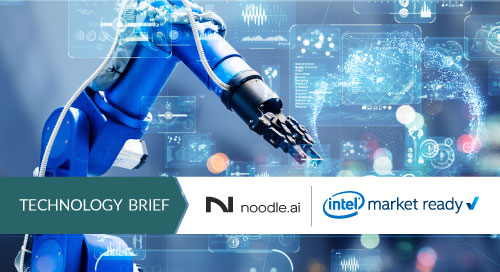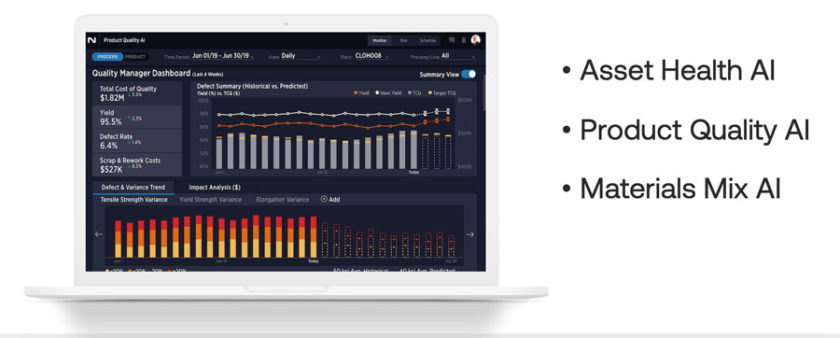How Manufacturers Can Push Past the AI Tipping Point

Industrial adoption of enterprise AI is at a tipping point. Early adopters have seen tangible benefits such as improved product quality and asset maintenance, but the wider manufacturing sector has been slow to take full advantage of AI.
What’s holding back progress? One element missing is AI-ready data infrastructure.
Industrial AI needs to know when and where production events happen—for example, to track scrap metal on its journey to becoming a finished coil of steel as it moves through a mill. Platforms like SQL and Hadoop are poorly suited to this task because they lack the ability to track time and place of materials in a production process.
Thus, the journey to a smart factory requires a complete rethinking of how information is captured from sensors on manufacturing equipment.
But building an AI-ready database has many elements. The true power of AI is its ability to correlate events across the organization, starting from raw data from individual assets on the factory floor (L0) all the way to enterprise software (L4). If these systems lack a shared sense of time and space, how will their data be interpreted?
Many operating technology (OT) systems remain disconnected from the larger IT infrastructure. This is particularly true on the factory floor, where many machines do not work in an interconnected way, let alone with an AI-ready data infrastructure.
“If you are going to become enterprise AI-ready, you have to change the way you collect data,” argued Spencer Doyle, Vice President, Platform and Channels at AI start-up Noodle.ai. “Data needs to be specifically organized for AI access in the same way that it needs to be curated for a data lake or a business intelligence relational database—but with magnitudes more fidelity—we’re talking petabytes.”
What will start the next smart factory revolution? An enterprise AI platform. @NoodleAI
A New AI Infrastructure
To solve the problem, Noodle.ai saw that an entirely new data structure was needed—one that can capture precisely timed and located data, from factory equipment all the way up to ERP systems. That’s why the company built its Enterprise AI Platform, an end-to-end solution that integrates with the full spectrum of OT and IT systems (Figure 1).

By centralizing all this data into a unified, time-and-space-aware system (a temporal-spatial correlation database), the Noodle.ai Enterprise AI Platform can detect anomalies and connect findings to machine learning algorithms in its applications such as Noodle.ai’s Vulcan Manufacturing Suite Product Quality AI application. With its intuitive interface, the Vulcan suite enables manufacturers to tackle critical issues such as asset health, product quality, and supply chain management (Figure 2).

Unifying data in a shared platform is crucial. For example, understanding when a machine is failing, and more important, why, has direct implications for product quality, production line scheduling, and more.
A shared platform is also important because enterprise AI is not one, but a set of, interconnected applications. “You need to build hundreds of AI models, some that are tiny little algorithms that matter just for one asset and some that look at the entire system,” explained Doyle.
“Each of these AI models is not only going to be performing a different function and asking a different question of the data sets, but ultimately they’re going to be combined to feed complex data science algorithms to deliver recommendations on how to optimize plant operations.” Doyle said.
Building a Smart Factory Architecture
Achieving this goal requires careful design at every level of the enterprise data stack. On the factory floor, a shared notion of time is again the key. “If you are enforcing precision time protocol,” said Doyle, “you will be able to create time series data. Whether it’s a Honeywell, or a Rockwell, it doesn’t matter.”
Precise timing is important because the clocks on different systems will drift apart over time. To an AI system, this drift will appear as a change in the process length, leading to inaccurate assessments of performance.
Synchronization is also critical for ERP and other IT systems. “That’s part of our secret sauce,” Doyle noted. “We take a timestamp, tilt it on its side, and scissor it with the timestamps coming off of your assets, so that your SAP ERP system is perfectly synchronized with your factory systems.”
Storage and Reliability Are Critical for AI
This leaves the question of where the data should physically reside. Public clouds are one option, but they can impose unacceptable latencies. After all, the end goal for industrial-grade enterprise AI is a factory capable of making decisions and taking action in real time at the edge.
Reliability is another concern. “What happens when the factory network goes out?” asked Doyle. “You’ve got to have the backup on the factory floor to maintain temporal continuity of the data set.”
This means enterprises need to build petabyte-scale AI systems on-site—a daunting challenge, to say the least. That’s why Noodle.ai has taken an AI-as-a-Service approach, partnering with Dell EMC to deliver an end-to-end software and hardware solution.
“Setting us up is actually quite simple,” said Doyle. “You use your preferred systems integrator. You put Intel® powered Dell Edge Gateways and Dell R740s in the factory, and you commission Noodle.ai to build your private stack, and we manage the entire thing.” (Figure 3)

This approach also makes security a snap. “What we offer is a closed appliance that has an edge device that can be secured by the customer’s security profile, so the CISO can put their endpoint software at the edge. Their CISO can walk to our data center and put their endpoint software on the rack, so it’s just another node on their network,” Doyle said.
The Time to Start Is Now
Rapid adoption of enterprise AI by manufacturers is critical, because the experienced generation of machine operators is gradually retiring. Their operational knowledge is needed to inform the constantly learning AI model, which is trained over time—a process that values human override and input.
“We’re lucky to have this technology called AI that’s capable of taking an input from a human being and then using that input as a variable the next time the system makes a decision,” said Doyle. But with so many workers retiring in the next 10 years, time is running short.
“Get your enterprise AI system implemented, then get it in front of your experienced operators who are not used to interacting with such technologies,” said Doyle. “It is almost a moral imperative to honor the legacies of these folks who’ve run your machines and plants for 20 or 30 years to capture their decades of knowledge and experience operating their factories.”